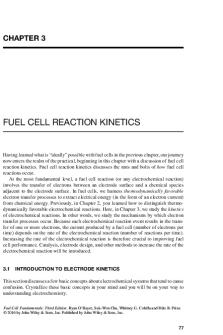Fuel cell with Schematic diagram PDF

| Title | Fuel cell with Schematic diagram |
|---|---|
| Course | Power Engineering |
| Institution | PES University |
| Pages | 4 |
| File Size | 177.7 KB |
| File Type | |
| Total Downloads | 71 |
| Total Views | 127 |
Summary
Prof. Megha...
Description
Fuel cell with Schematic diagram A Fuel cell is an electrochemical device in which the chemical energy of a conventional fuel is converted directly and efficiently into low voltage, direct-current electrical energy. One of the chief advantages of such a device is that because the conversion, atleast in theory, can be carried out isothermally, the Carnot limitation on efficiency does not apply. A fuel cell is often described as primary battery in which the fuel and oxidizer are stores external to the battery and fed to it as needed.
Fig. shows a schematic diagram of a fuel cell. The fuel gas diffuses through the anode and is oxidized, thus releasing electrons to the external circuit; the oxidizer diffuses through the cathode and is reduced by the electrons that have come from the anode by way of the external circuit.
The fuel cell is a device that keeps the fuel molecules from mixing with the oxidizer molecules, permitting, however, the transfer of electrons by a metallic path that may contain a load.
Of the available fuels, hydrogen has so far given the most promising results, although cells consuming coal, oil or natural gas would be economically much more useful for large scale applications.
Figure: Schematic of a fuel cell. Some of the possible reactions are :
Hydrogen/oxygen 1.23 V : 2H2 + O2 -> 2 H2O Hydrazine 1.56 V N2H4 + O2 -> 2H2O + N2 Carbon (coal) 1.02 V C + O2 -> CO2 Methane 1.05 V CH4 + 2O2 -> CO2 + 2H2O Hydrogen-oxygen cell :
The hydrogen-oxygen devices shown in figure is typical of fuel cells. It has three chambers separated by two porous electrodes, the anode and the cathode. The middle chamber between the electrodes is filled with a strong solution of potassium hydroxide. The surfaces of the electrodes are chemically treated to repel the electrolyte, so that there is minimum leakage of potassium hydroxide into the outer chambers. The gases diffuse through the electrodes, undergoing reactions are show below:
4KOH 4K+ + f(OH)Anode: 2H2 + 4 (OH)- 4H2O + 4eCathode: O2 + 2H2O + 4e- 4 (OH)-
Cell reaction
2H2 + O2 2H2O
The water formed is drawn off from the side. The electrolyte provides the (OH)- ions needed for the reaction, and remains unchanged at the end, since these ions are regenerated. The electrons liberated at the anode find their way to the cathode through the external circuit. This transfer is equivalent to the flow of a current from the cathode to the anode.
Such cells when properly designed and operated, have an open circuit voltage of about 1.1 volt. Unfortunately, their life is limited since the water formed continuously dilutes the electrolyte. Fuel efficiencies as high as 60%-70% may be obtained.
Figure: Hydrogen-oxygen fuel cell....
Similar Free PDFs

Fuel cell with Schematic diagram
- 4 Pages

Layout Schematic Diagram
- 4 Pages

FUEL CELL REACTION KINETICS
- 40 Pages

Fuel cell fundamentals-solutions
- 87 Pages

Fuel Cell Engines -Mench 2008.pdf
- 526 Pages

Cell Size-KEY with work
- 9 Pages

Fuel Prices
- 4 Pages

Ultra 96-V2 Rev1 Schematic
- 18 Pages

Arduino-uno-schematic
- 1 Pages

FUEL PUMP
- 33 Pages

PHASE DIAGRAM (DIAGRAM FASA
- 14 Pages
Popular Institutions
- Tinajero National High School - Annex
- Politeknik Caltex Riau
- Yokohama City University
- SGT University
- University of Al-Qadisiyah
- Divine Word College of Vigan
- Techniek College Rotterdam
- Universidade de Santiago
- Universiti Teknologi MARA Cawangan Johor Kampus Pasir Gudang
- Poltekkes Kemenkes Yogyakarta
- Baguio City National High School
- Colegio san marcos
- preparatoria uno
- Centro de Bachillerato Tecnológico Industrial y de Servicios No. 107
- Dalian Maritime University
- Quang Trung Secondary School
- Colegio Tecnológico en Informática
- Corporación Regional de Educación Superior
- Grupo CEDVA
- Dar Al Uloom University
- Centro de Estudios Preuniversitarios de la Universidad Nacional de Ingeniería
- 上智大学
- Aakash International School, Nuna Majara
- San Felipe Neri Catholic School
- Kang Chiao International School - New Taipei City
- Misamis Occidental National High School
- Institución Educativa Escuela Normal Juan Ladrilleros
- Kolehiyo ng Pantukan
- Batanes State College
- Instituto Continental
- Sekolah Menengah Kejuruan Kesehatan Kaltara (Tarakan)
- Colegio de La Inmaculada Concepcion - Cebu




